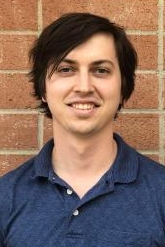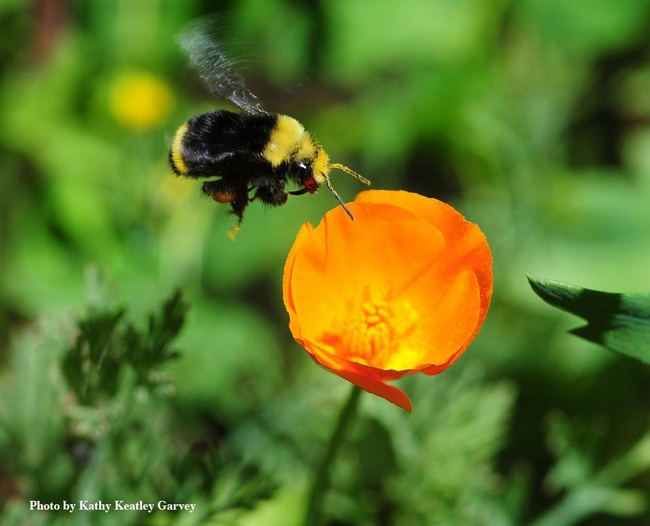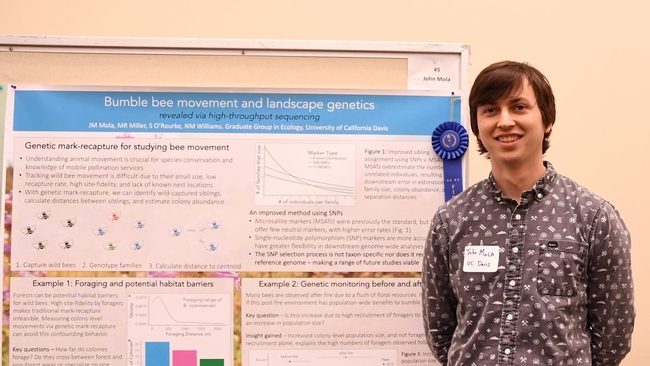
And now doctoral candidate John Mola of the Neal Williams lab, UC Davis Department of Entomology and Nematology, will present his exit seminar on "Bumble Bee Movement Ecology and Response to Wildfire" at 4:10 p.m., Wednesday, Oct. 9 in Room 122 of Briggs Hall.
Mola, who specializes in bee biology, pollinator ecology and population genetics, says in his abstract:
"Observing bumble bees on flowers can be a deceptive practice. When standing in a field looking at a bunch of bees, we have little clue about the distances they traveled to get there or the number of colonies to which the individuals belong. However, modern genetic tools let us reveal this unseen information. In my dissertation I use genetic mark-recapture to understand two areas of general ecological interest and apply them to bumble bees: organismal movement and disturbance ecology. In this talk I discuss what I learned about bumble bee movement ecology in a subalpine meadow complex and insights gained from an unexpected opportunity to study the response of a bumble bee population to wildfire."
Mola holds a bachelor of science degree in environmental studies from Florida State University, and a master's degree in biology at Humboldt State University. He enrolled in the UC Davis Ph.D. program in ecology in 2014.
In August 2019 Mola published a "Review of Methods for the Study of Bumble Bee Movement" in Apidologie with his major professor, co-author and pollination ecologist Neal Williams. The abstract:
"Understanding animal movement is critical for conservation planning, habitat management, and ecological study. However, our understanding is often limited by methodological constraints. These limitations can be especially problematic in the study of ecologically and economically important pollinators like bumble bees, where several aspects of their biology limit the feasibility of landscape-scale studies. We review the methods available for the study of bumble bee movement ecology, discussing common limitations and tradeoffs among several frequent data sources. We provide recommendations on appropriate use for different life stages and castes, emphasizing where recent methodological advances can help reveal key components of understudied parts of the bumble bee life cycle such as queen movement and dispersal. We emphasize that there is no one correct method and encourage researchers planning studies to carefully consider the data requirements to best address questions of interest."
Mola expanded on the topic on his website: "This manuscript contains more within it than the title alone lets on. Understanding the landscape-scale movements of bumble bees has long-plagued researchers despite heavy interest. In some ways reviewing the methods is to review the history of bumble bee movement research. We cover the tools one may use for tracking bumble bees. We also include information on how to interpret and contextualize results, considerations on conceptualizing bumble bee movement, and suggestions for future research efforts. I think folks will find the table and supplemental information particularly handy in planning research and writing manuscripts (we provide a long list of great studies on bumble bee movement in the supplemental). If you're really interested in the research area, consider coming to BOMBUSS 2.0 where Jamie Strange and I will be co-leading a session on this very topic. https://wildlifepreservation.ca/about-bombuss/"
In 2018, Mola wowed the judges at the graduate student research poster competition at the fourth annual UC Davis Bee Symposium for his work on "Bumble Bee Movement and Landscape Genetics." As the first-place winner, he received the $850 cash prize. The judges: Tom Seeley, professor at Cornell University, the symposium's keynote speaker; speaker Santiago Ramirez, assistant professor of evolution and ecology at UC Davis, and native pollinator specialist Robbin Thorp (1933-2019), distinguished emeritus professor at UC Davis.
“In conservation biology and ecological study, we must know the distances organisms travel and the scales over which they go about their lives,” Mola said of his work at the time. “To properly conserve species, we have to know how much land they need, how close those habitats need to be to each other, and the impact of travel on species success. For instance, if I'm told there's free burritos in the break room, I'm all over it. If the 'free' burritos require me traveling to Scotland, it's not worth it and I would spend more energy (and money) than I would gain. For pollinators, it's especially important we understand their movement since the distances they travel also dictates the quality of the pollination service they provide to crop and wild plants."
“Despite this importance, we know comparatively little about the movements of bees--the most efficient of pollinators--due to the difficulty of tracking individuals," Mola explained.
Mola says that "Unlike birds or large mammals, we can't just attach large radio collars and follow them around. As such, my work has focused on improving methods that we can use for study. I use a combination of landscape ecology and molecular genetics to identify the locations of siblings (colony-mates) in landscapes. From that information, we can infer all sorts of useful information about the potential foraging range, habitat use, population size, etc. It's a very exciting time to be working on these topics as the availability of new genetic and GPS technologies allows us to answer or re-address scientific and conservation issues with bees.”
Mola's next step: Fort Collins, Colo., where he will be a USGS (U.S. Geological Survey) Mendenhall postdoctoral fellow.
Attached Images:

